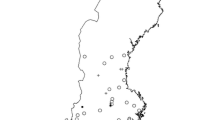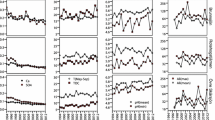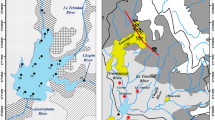Abstract
Side effects related to liming have been studied in four dimictic lakes (553–642 m a.s.l.; 59°57′N) in Finnemarka, a forested area in Southern Norway with poor catchment buffer capacity. Data series from lake profiles have been sampled two decades apart; 10 years prior to liming and after 10 years of liming. Water samples were collected during spring after ice breakup and during summer after the development of thermal stratification. Before liming, there were very low concentrations of bicarbonate (HCO –3 ; or alkalinity) in the lakes. After 10 years of liming, up to 90% of the ions in hypolimnion originate from lime products. Hence, liming strengthened the chemical stratification and increased the vertical stability. Differences in chemocline developments between lakes were explained by differences in physical properties, i.e. their depth/surface area ratio. The chemocline developments lead to increased concentrations of organic matter in the hypolimnion with a subsequent reduction in oxygen concentrations. Lime additions during late spring, as an alternative to early autumn, lead to pronounced anoxic conditions in the hypolimnion.




Similar content being viewed by others
References
Blomqvist, P. (1999). Phytoplankton responses to biomanipulated grazing pressure and nutrient additions—enclosure studies in unlimed and limed Lake Njupfatet, Central Sweden. Environmental Pollution, 111(2), 333–348.
Brandrud, T. E. (2002). Effects of liming on aquatic macrophytes, with emphasis on Scandinavia. Aquatic Botany, 73(4), 395–404.
Broberg, O. (1986). Nutrient responses to the liming of lake Gårdsjön. Hydrobiologia, 150, 11–24.
Bukaveckas, P. A., & Driscoll, C. T. (1991). Effects of whole-lake base addition on the thermal characteristics of three clearwater acidic lakes. Water, Air, and Soil Pollution, 59, 23–39.
Effler, S. W., Schafran, G. C., & Driscoll, C. T. (1985). Partitioning light attenuation in an acidic lake. Canadian Journal of Fisheries and Aquatic Sciences, 42(11), 1707–1711.
Evans, M., & Frick, C. (2001). The effects of road salts on aquatic ecosystems. Environmental Canada. Water Science and Technology Directorate.
Golterman, H. L., Clymo, R. S., & Ohnstad, M. A. M. (1978). Methods for physical and chemical analysis of fresh waters (p. 214). IBP Handbook No. 8.
Grøterud, O. (1987). Lake acidification—a complex phenomenon elucidated by studies of fifteen lakes in Finnemarka, Southern Norway. Norw.J.Agr. Sci.,Suppl. 1, revised edition, p 183.
Grøterud, O. (1997). Humic colour in lakes in relation to acidification, hydraulic loading and liming. Verhandlungen des Internationalen Verein Limnologie, 26, 313–318.
Haaland, S., Riise, G., Hongve, D., Grøterud, O., & Blakar, I. (2009). TOC concentrations in Norwegian lakes—the effect of sea-salts and anthropogenic acid components. Verh Int Verein Limnol, 30 (in press).
Hagley, C. A., Wright, D., Owen, C. J., Eiler, P., & Danks, M. (1996). Changes in aquatic macrophytes after liming Thrush Lake, Minnesota. Restoration Ecology, 4(3), 307–312.
Hakala, A. (2004). Meromixis as a part of lake evolution—observations and a revised classification of true meromictic lakes in Finland. Boreal Environment Research, 9, 37–53.
Henrikson, L., Hindar, A., & Thörnelöf, E. (1995). Freshwater liming. Water, Air, and Soil Pollution, 85(1), 131–142.
Hessen, D. O., Alstad, N. E. W., & Skardal, L. (2000). Calcium limitation in Daphnia magna. Journal of Plankton Research, 22(3), 553–568.
Hongve, D. (1980). Chemical stratification and stability of meromictic lakes in the Upper Romerike district. Schweizerische Zeitschrift für Hydrologie, 42, 171–195.
Houser, J. N. (2006). Water colour affects the stratification, surface temperature, heat content, and mean epilimnetic irradiance of small lakes. Canadian Journal of Fisheries and Aquatic Sciences, 63, 2447–2455.
Kirste, N.-Y. (2000). A study of four freshwater lakes in Finnemarka, focusing on liming associated problems (p. 62). Ås: Thesis MSc. Norwegian University of Life Sciences (UMB).
Kjensmo, J. (1997). The influence of road salts on the salinity and the meromictic stability of Lake Svinsjoen, southeastern Norway. Hydrobiologia, 347, 151–158.
Leenheer, J. A., & Reddy, M. M. (2008). Co-precipitation of dissolved organic matter by calcium carbonate in Pyramid Lake, Nevada. Annals of Environmental Science, 2, 11–25.
Monteith, D. T., Stoddard, J. L., Evans, C. D., de Wit, H. A., Forsius, M., Høgåsen, T., et al. (2007). Dissolved organic carbon trends resulting from changes in atmospheric deposition chemistry. Nature, 450, 537–541.
Morabito, G., Ruggiu, G., & Panzani, P. (2001). Trends of phytoplankton characteristics and their communities in pre- and post-liming time in Lake Orta (1984–1998). Journal of Limnology, 60(1), 91–100.
Ottesen, B. (1998). A chemical water study of two limed dystrophic lakes. Ås: Thesis MSc. Norwegian University of Life Sciences (UMB). 106.
Ramakrishna, D. M., & Viraraghavan, T. (2005). Environmental impact of chemical deicers—a review. Water, Air, and Soil Pollution, 166, 49–63.
Schindler, D. W. (1988). Effects of acid rain on freshwater ecosystems. Science, 239, 149–157.
Schindler, D. W., Curtis, P. J., Parker, B. R., & Stainton, M. P. (1996). Consequences of climate warming and lake acidification for UV-B penetration in North American boreal lakes. Nature, 379, 705–708.
Schöpp, W., Posch, M., Mylona, S., & Johansson, M. (2003). Long-term development of acid deposition (1880–2030) in sensitive freshwater regions in Europe. Hydrology and Earth Sciences, 7(4), 436–446.
Snucins, E., & Gunn, J. (2000). Interannual variations in the thermal structure of clear and coloured lakes. Limnology and Oceanography, 45(7), 1639–1646.
Steinberg, C. E. W., Kamara, S., Prokhotskaya, V. Y., Manusadžianas, L., Karasyova, T. A., Timofeyev, M. A., et al. (2006). Dissolved humic substances—ecological driving forces from the individual to the ecosystem level. Freshwater Biology, 51(7), 1189–1210.
Walker, K. F. (1974). The stability of meromictic lakes in Central Washington. Limnology and Oceanography, 19, 209–222.
Wetzel, R. G. (2001). Limnology (1006pp). 3 edn. Academic Press.
Acknowledgement
We are grateful to Nils-Yrje Kirste for giving us permission to use data derived from his MSc thesis.
Author information
Authors and Affiliations
Corresponding author
Rights and permissions
About this article
Cite this article
Grøterud, O., Haaland, S. Side Effects of Liming - A Study of Four Dimictic Lakes in Southern Norway. Water Air Soil Pollut 211, 135–141 (2010). https://doi.org/10.1007/s11270-009-0287-2
Received:
Accepted:
Published:
Issue Date:
DOI: https://doi.org/10.1007/s11270-009-0287-2




